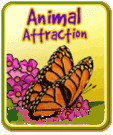
Experiment Category:
Objective:
What You Need:
- Any sort of crafts supply you have on hand: construction paper, cups, pipe cleaner, craft sticks, aluminum foil, crayons, markers, rubber bands, etc.
- Scissors
- glue, tape or other fastening materials
- perfume or scented things
To Do and Observe:
This is an activity to try outside in spring or summer.
Carefully study a few real flowers. Examine the shape, size, color, texture, scent, angle of growth, and markings of each part. Try to predict what attracts pollinators to each flower. Watch the flowers outside to see if your prediction is correct.
Make your own imitation flower and try to fool a bee or other pollinator into visiting your flower. Read the pollinator facts from the on-line activity and try to make your flower match the pollinator's favorite colors, shapes, etc. Use any materials you like to mimic a real flower or make up your own design.
Put your fake flower outside and see if you attract a pollinator. If after 5 minutes your flower is unsuccessful, make some changes: move it to a different location, add some markings, or remove a part and try again until you are successful.
As you proceed, try to answer some of these questions: Is your fake flower more successful if it is placed near some real flowers? Which aspect of a flower is most important for attracting a pollinator: color, shape, size, material, scent, location, other? Can you make up a flower design that works as well as a real flower design? Is it possible to attract a pollinator that is not already present in your area?
What's Going On:
Flowers and pollinators have evolved together. Animals that learned to find food inside a flower survived and passed their knack for finding food on to the next generation. Flowers that successfully \"marketed\" to their pollinators made more seeds and passed their characteristics onto new plants. Over time, the pollinators and plants developed a very important interdependent relationship.
Some flowers attract more than one kind of pollinator. Such flowers tend to be round and regular. Flowers that are more unusual (orchids, for example) usually invite only one specific pollinator. In such cases, the extinction of either the flower or the pollinator means the certain extinction of the other.
In addition to the six pollinators shown here, ants, wasps, small mammals, and even slugs serve as pollinators for some flowers. You might be interested in investigating some of these pollinators: the fig wasp, the honey-creeper (a bird), or the Australian honey-possum.
Parent/Teacher Tips:
Help the child think about how each part of the flower design plays a part in advertising or accommodating the pollinator. Let the child describe the reasons for her/his design.
Safety note: Bees will not sting if they are unprovoked. Remind children to move slowly and not to swat at bees that fly close, but learn to relax. As long as the bees do not perceive a threat they will go about their business of collecting nectar and will ignore humans around them. If the child is known to be allergic to bee stings, s/he may prefer to design a flower to attract a different kind of pollinator.

Comments
a
good
I would say it is really good